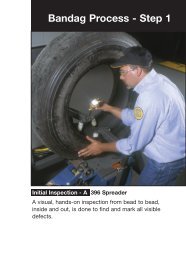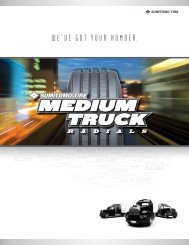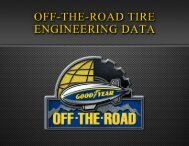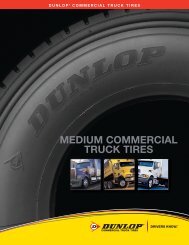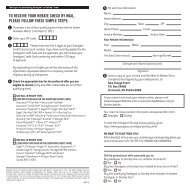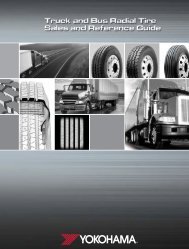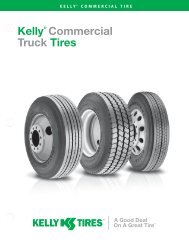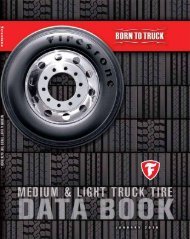Bridgestone Medium and Light Truck Tire Data Book - Sullivan Tire ...
Bridgestone Medium and Light Truck Tire Data Book - Sullivan Tire ...
Bridgestone Medium and Light Truck Tire Data Book - Sullivan Tire ...
You also want an ePaper? Increase the reach of your titles
YUMPU automatically turns print PDFs into web optimized ePapers that Google loves.
General Technical Information<br />
2010 <strong>Bridgestone</strong> <strong>Medium</strong> <strong>and</strong> <strong>Light</strong> <strong>Truck</strong> <strong>Tire</strong> <strong>Data</strong> <strong>Book</strong><br />
Technical Bulletins Load/Inflation General Technical <strong>Light</strong> <strong>Truck</strong> <strong>Medium</strong> <strong>Truck</strong><br />
WIDE BASE<br />
181 lb per TIRE<br />
LOW PROFILE<br />
250 lb per PAIR<br />
Wide base tires<br />
can allow weight<br />
savings to be<br />
converted into<br />
revenue-producing<br />
payload <strong>and</strong> may be<br />
more fuel-efficient<br />
than ordinary dual<br />
assemblies.<br />
If the tires they replace were not fuel-efficient, wide<br />
base tires may also contribute to fuel economy.<br />
<strong>Tire</strong> Contributions to the Fuel Bill<br />
Of the fuel used in moving the vehicle, about ¼ to 1⁄3 of<br />
it is used to overcome rolling resistance. So if rolling<br />
resistance decreases by 10 percent the result is about<br />
(¼ x 10% =) 2.5% to (1⁄3 x 10% =) 3% decrease in fuel<br />
consumption.<br />
Rolling resistance in the tire<br />
The tread contributes about 35-50 percent of the tire’s<br />
overall rolling resistance, while the casing contributes<br />
about 50 to 65 percent.<br />
35-50%<br />
Tread<br />
Compound<br />
50-65%<br />
Casing<br />
Wear effect on rolling resistance<br />
Cap<br />
Base<br />
Since the contribution of the tread is large, as the<br />
tread wears away, rolling resistance decreases.<br />
As they approach wear-out, many tires become very<br />
similar in rolling resistance, even if they started out<br />
quite different.<br />
That’s one reason the BBTS TLCC program uses<br />
true average rolling resistance – not new-tire rolling<br />
resistance – to calculate tire fuel consumption.<br />
Tread design<br />
new<br />
30% worn = 2% savings<br />
50% worn = 4.5% savings<br />
80% worn = 6.5% savings<br />
Tread design also affects rolling resistance. In general,<br />
rib-type designs are more fuel-efficient than block- or<br />
lug-types. And, a tire with a shallower tread tends to<br />
be more fuel-efficient.<br />
With drive tires, designs incorporating continuous<br />
shoulder ribs are so resistant to irregular wear<br />
that designers can use very fuel-efficient tread<br />
compounds.<br />
Computer analysis, like that of the BBTS TLCC<br />
program, can help you decide which tires deliver the<br />
best fuel efficiency.<br />
Fuel economy with retreads<br />
If only the tread is modified to produce fuel<br />
economy, the fuel efficiency of the tire may end<br />
when it is retreaded, unless it’s retreaded with a fuelefficient<br />
tread.<br />
Fortunately, there are a number of fuel-efficient<br />
retread materials available offering fuel economy<br />
comparable to that of the best new tires, but at a<br />
fraction of their cost.<br />
In addition, many BBTS casings are specially<br />
constructed for fuel efficiency, <strong>and</strong> when retreaded<br />
– especially when capped with a fuel-efficient tread –<br />
may offer superior fuel economy.<br />
86



